Important ancient Inscriptions and Edicts
Ashokan Edicts and Inscriptions
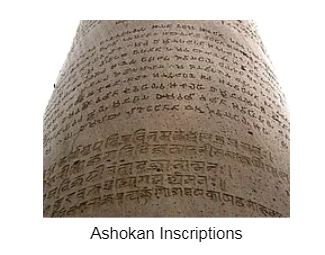
- Emperor Ashoka was a strong ruler of the Maurya dynasty.
- He converted to Buddhism after witnessing the devastating impacts of war in Kalinga.
- Cave inscriptions, pillar edicts, and rock edicts are the three types of inscriptions discovered.
- In the 'Bhabru Edict,' he expressed his faith in Buddhism's Three Jewels.
- Ashoka constructed pillars and edicts in different regions, including present-day Afghanistan, Nepal, Bangladesh, and Pakistan, to propagate Buddha's ethical teachings.
- He promoted Dhamma throughout his empire and neighbouring areas.
King Ashoka’s Dhamma
- In 260 BC, King Ashoka chose Buddhism as the main religion and centred his rule on Dhamma.
- Dhamma, based on Buddha's teachings, wasn't just a religion but a way of life.
- Ashoka's Dhamma focused on how people should behave, being kind, and governing with compassion, as shown in his 14 edicts.
- He highlighted the importance of respecting parents, teachers, and religious leaders, and promoted non-violence and truthfulness.
- Ashoka's Dhamma policies included stopping cruel practices, building things like roads and hospitals, and taking care of the poor and old people.
- Dhamma Mahamatras were chosen to spread these ideas, even outside of his own kingdom.
Ashokan Inscriptions : Rock Edicts
- The four types of Edicts of Ashoka are 33 writings that can be grouped into:
- Major rock edicts
- Minor rock edicts
- Major pillar edicts
- Minor pillar edicts
- These edicts were grouped based on the surfaces they were written on.
- In 1837, James Princep decoded the Ashokan writings for the first time.
- The edicts were more about how Ashoka thought society and government should work, rather than just religion. They were put in public places and along trade routes so many people could read them.
- The inscriptions on rocks show how Ashoka spread his "Law of Piety."
1.Major Rock Edicts
- Ashoka's main rock writings talk about how he wanted people to live peacefully by following the dhamma.
- There are about 14 important rock writings that are detailed and lengthy.
- Ashoka wrote all these important rock writings on big rocks, except for the Kandahar Greek writing.
- These writings were placed on the borders of the area ruled by Emperor Ashoka.
|
Ashoka Rock Edicts |
Features Inscribed in Edicts |
|
Major Rock Edict I |
|
|
Major Rock edict II |
|
|
Major Rock Edict III |
|
|
Major Rock Edict IV |
|
|
Major Rock edict V |
|
|
Major Rock Edict VI |
|
|
Major Rock Edict VII |
|
|
Major Rock Edict VIII |
|
|
Major Rock Edict IX |
|
|
Major Rock Edict X |
|
|
Major Rock Edict XI |
|
|
Major Rock Edict XII |
|
|
Major Rock edict XIII |
|
|
Major Rock Edict XIV |
|
2.Minor Rock Edicts
- Minor rock edicts are on 15 rocks in the country and Afghanistan.
- They came before the Major rock edicts.
- They tell about Ashoka's life and summarise his dhamma.
- You can find these edicts mostly in Maski (Andhra Pradesh), Brahmagiri (Karnataka), Sasaram (Bihar), Rupanath (Madhya Pradesh), and Bhabru - Bairat (Rajasthan).
- In these writings, Ashoka calls himself "Beloved servant of God" (Devanam Piyadasi).
- An inscription in Maski confirms that Devanampiyadasi is Ashoka.
- Ashoka uses his name in only four places: Maski (AP), Brahmagiri (Karnataka), Gujjara (MP), and Nettur (AP).
- Minor rock edict number 3 lists important Buddhist texts for Buddhist clergy to study regularly.
- The writings are short, and the quality of the inscriptions is not very good.
3.Major Pillar Edicts
- There are seven Major pillar edicts.
- Major pillar edicts of Ashoka refer to those written only on the Pillars of Ashoka.
- Major rock edicts and minor rock edicts come before them in time.
- These inscriptions were made during the last period of his rule.
- Almost all major pillar edicts are in Central India, except for two.
- Two types of stones were used: spotted white sandstone (from Mathura) and buff-coloured sandstone and quartzite (from Amaravati), mostly from Chunar.
- Pillars are single stones with polished surfaces, having similar sizes and shapes.
- Found in various places including Kandahar (Afghanistan), Khyber Pakhtunkhwa (Pakistan), Delhi, Vaishali, and Champaran (Bihar), Sarnath and Allahabad (Uttar Pradesh), Amaravati (Andhra Pradesh), and Sanchi (Madhya Pradesh).
- The pillars show important symbols in Buddhism, like elephants, lions, wheels, and lotuses.
- A platform (abacus) at the top of the bell capital supports the crowned animal.
|
Major Pillar Edicts |
Features Inscribed in Edicts |
|
Pillar Edict I |
Ashoka’s principles relating to protection of his people |
|
Pillar Edict II |
Dhamma is defined as the minimum of sins, possession of compassion, liberty, virtues, purity, and truthfulness. |
|
Pillar Edict III |
Sins such as harshness, anger, cruelty, etc., are being abolished |
|
Pillar Edict IV |
The duties of Rajukas are mentioned |
|
Pillar Edict V |
- A list of animals and plants that should not be killed on certain occasions |
|
- A list of animals and plants that should never be killed |
|
|
- Describes the release of 25 prisoners by Ashoka |
|
|
- This pillar edict is also known as Delhi-Topra Pillar Edict |
|
|
Pillar Edict VI |
Policy of Dhamma is explained (welfare of the people) |
|
Pillar Edict VII |
Tolerance towards all religious sects. |
4.Minor Pillar Edicts
- The minor pillar edicts refer to the 5 minor edicts inscribed on the pillars of Ashoka.
- They are preceded by minor rock edicts.
- These edicts belong to the initial period of Ashoka’s reign.
|
Minor Pillar Edicts |
Features Inscribed in Edicts |
|
The schism edicts |
Warning of punishment for dissent in Samgha |
|
The Queen’s edicts |
Ashoka announces that gifts of the Queens should be credited |
|
Nigali Sagar pillar inscriptions |
Mentions about Ashoka’s dedication to increase the height of Kanakamuni Buddha |
|
Rummindei pillar inscriptions |
Mentions about Ashok’s visit to Lumbini i.e. birthplace of Buddha |
Ashoka Edicts : Languages
- Only three languages were used in the Ashoka edicts – Prakrit, Aramaic and Greek.
- Most of the Ashoka inscriptions were in Prakrit language written in Brahmi script (left to right).
- Mansehra and Shabazgiri in the northwest are the only scripts in Kharosthi (right to left).
- Inscriptions in Afghanistan were bilingual i.e., written in both Greek and Aramaic script.
- Example - The Kandhar rock inscription
Significant Features of the Ashokan Edicts
- Asoka's edicts depict him as a parental figure, highlighting the king-subject relationship as that of a father and child.
- Despite his diverse religious interests, Ashoka criticised meaningless rituals and sacrifices.
- He encouraged generosity and kindness toward both ascetics (sramanas) and priests (Brahmins).
- Ashoka stressed upon the importance of upholding social duties and civic morals.
- Several major rock edicts discuss various aspects of the Ashoka Dhamma, alongside discussions on being compassionate and humane.
Important facts of the Ashoka Edicts
- In Ashoka edicts, the emperor (Ashoka) refers to himself as Devanampiya Piyadasi which means beloved of Gods.
- The name Ashoka is explicitly mentioned only in three rock edicts which are in Maski, Gujjara and Nittur.
- Ashoka was the first king to make direct connection to the people via his inscriptions
- These inscriptions were mostly placed on the ancient highways.
Other Important Edicts and Inscriptions
1.Sohgaura Copper Plate
The Sohgaura copper plate, an ancient Mauryan record, references relief efforts during a famine. It is among the few pre-Ashoka Brahmi inscriptions found in India.
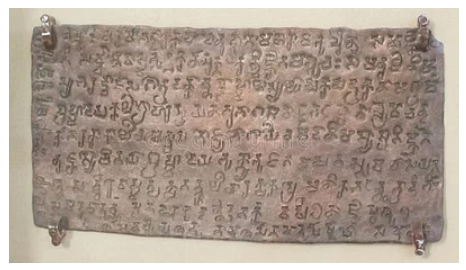
2.Rummindei Pillar Edicts (Lumbini, Nepal)
- The inscriptions, categorised as Minor Pillar Inscriptions, are dedicated to nature.
- They record Ashoka's trip to Lumbini (Rummindei), the birthplace of Lord Buddha in Nepal's Rupandehi district. Ashoka exempted Lumbini from taxes and established its grain contribution at one-eighth.
- These inscriptions are inscribed in the Brahmi script.
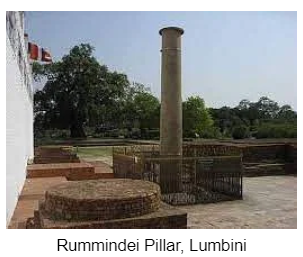
3.Mehrauli Pillar Inscription/ Garuda Pillar
- The Mehrauli Iron Pillar was originally positioned near the Beas River and later moved to Delhi by a Delhi king. It is currently located in Delhi's Qutub Minar complex.
- Its construction using rust-resistant metals is a notable feature.
- The pillar commemorates Chandragupta's triumph over the Vanga Countries, where he battled alone against a coalition of adversaries.
- It also celebrates his victory over the Vakatakas across the seven mouths of Sindhu.
- Chandragupta-II of the Gupta dynasty, known as Vishnupada, dedicated this pillar to honour Lord Vishnu.
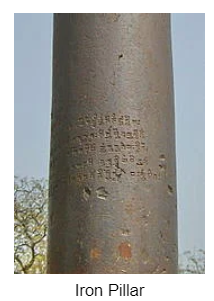
4.Allahabad Pillar Inscription (Prayag Prasasti)
- "Prayag" signifies a meeting place, and it is an ancient name for Allahabad, where the Ganga, Yamuna, and mythical Saraswati rivers converge.
- Prashasti is a tribute or eulogy in honour of someone.
- The Allahabad Prasasti was originally engraved on the Ashokan Pillar in Kaushambi near Allahabad and was later moved to the Allahabad fort.
- Despite being an Ashokan Stambh, it contains four different inscriptions.
- The standard Ashokan inscriptions in Brahmi script are present on all pillars.
- It includes an edict praising Ashoka's wife Kaurwaki's charitable deeds.
- The inscriptions of Samudragupta, written in Sanskrit and Brahmi script by Harisena (335–375 AD), discuss Samudragupta's conquests and the boundaries of the Gupta Empire.
- There are also Persian inscriptions from Jahangir's era.
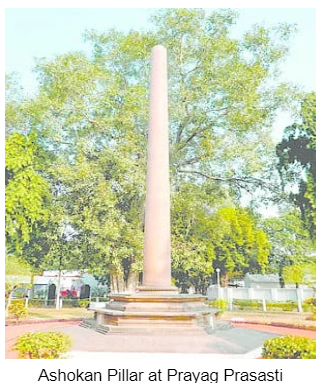
5.Kalsi Inscription
- Kalsi, situated by the Yamuna River between Chakrata and Dehradun, holds historical significance.
- Ashoka's inscriptions at Kalsi are unique as they represent the only complete set of fourteen rock edicts in North India.
- The edicts are in the Prakrit language and Brahmi script.
- The Rock edict, made of quartz, measures 8 feet wide and 10 feet long, dating back to around 450 B.C.
- Reflecting his conversion to Buddhism, Ashoka's rock edicts demonstrate a humane approach to internal governance.
- The edicts also emphasise policies supporting nonviolence and the reduction of warfare.
- They provide insights into Ashoka's life before his spiritual transformation.
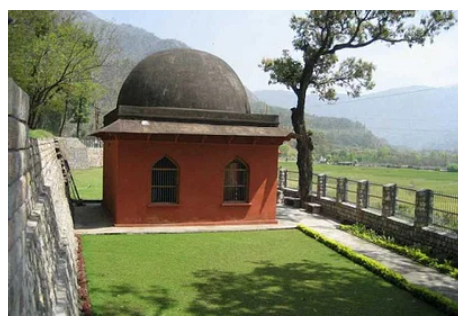 Kalsi Rock Edicts
Kalsi Rock Edicts
6.Maski Inscription
- Maski, situated in Karnataka's Raichur district, is an archaeological site located on the banks of the Maski River, a tributary of the Tungabhadra.
- The site houses a minor rock edict of Emperor Ashoka, which notably features Ashoka's name directly, instead of 'Devanampriya' or 'Piyadassi.'
- The inscription, still a dharma shasana, advises people to adhere to the principles of Buddhism.
- Additionally, the inscription indicates the extension of Mauryan rule to the Krishna valley in northeastern Karnataka.

7.Kalinga Edicts
- Kalinga, located in present-day Odisha, bears witness to its ancient heritage that spans over a thousand years.
- The Kalinga War marked a turning point in Ashoka's life, leading him to forsake his aspiration of conquering all territories and adopt the path of non-violence and Buddhism.
- Among the set of Rock Edicts, eleven of Ashoka's famous fourteen Rock Edicts are present.
- These edicts are inscribed in Magadhi Prakrit using an early Brahmi script.
- Instead of the eleventh, twelfth, and thirteenth rock edicts, two special edicts called Separate Rock Edicts or Kalinga Edicts were included, aiming to establish peace and pacify the newly conquered people of Kalinga.
8.Aihole Inscriptions
- Aihole in Karnataka served as the first capital of the Chalukyas.
- Numerous inscriptions were found at Aihole, with the Aihole inscription at Meguti Temple witnessing several significant historical events during the Chalukya period.
- The inscription, written in Sanskrit, is in the Kannada script.
- It references Pulakeshin II's victory over Harshavardhana and the Chalukyas' triumph over the Pallavas.
- Additionally, it mentions the transfer of the capital from Aihole to Badami.
- The inscriptions were authored by Ravikirti, the court poet of Pulakeshi II, who ruled from 610 to 642 CE.
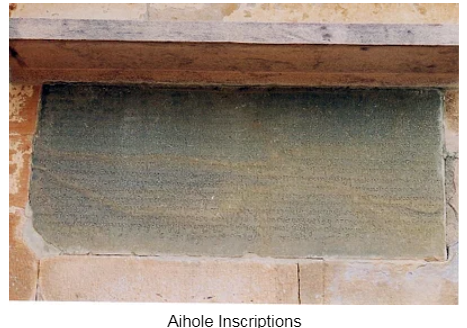
9.Junagarh Rock inscription
- Rudradaman's Junagarh Rock inscription, written around the mid-second century AD, is one of the early examples of pure Sanskrit.
- It talks about the building of a dam on Sudarshana Lake near Girnar in Kathiawar, managed by Pushyagupta, one of Chandragupta Maurya's governors.
- Another Skandagupta inscription indicates that the dam was repaired during his rule, nearly 800 years after it was first built.
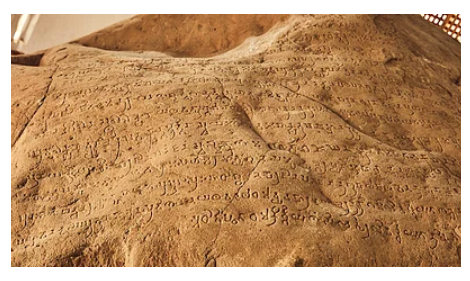
10.Nasik Inscription
- Gautamiputra Satkarni's mother, Gautami Balasri, documented his achievements in the Nasik Inscription.
- The Nasik Prasasti confirms Gautamiputra as the ruler.
- According to the inscription, Gautamiputra fought against the Saka King Nahapana and restored the reputation of his dynasty.
11.Hathigumpha Inscription
- King Kharavela wrote the Hathigumpha Inscription during the second century BCE in Odisha's Udayagiri-Khandagiri Caves.
- The Hathigumpha Inscription consists of seventeen lines in Prakrit and Brahmi script.
- The primary source of information about Kalinga ruler Kharavela is the Hathigumpha Inscription found at Udayagiri Caves.
- It narrates Kharavela's story as a king, conqueror, supporter of culture, and advocate of Jainism.
- The Hathigumpha Inscription is the sole Indian inscription that provides year-by-year details of a ruler's achievements.
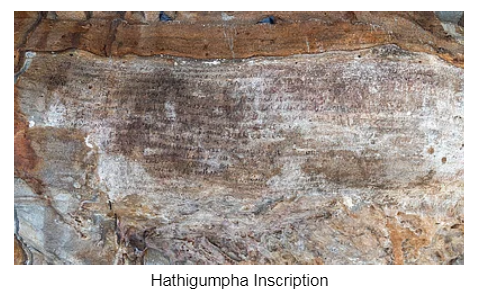
12.Ben Sagar/ Vidisha Inscription
- Located at the ancient site of Vidisha in present Madhya Pradesh state.
- This pillar inscription was constructed by Heloidorus, the Greek ambassador and belongs to the Sunga period (2nd century BC).
- Written in Prakrit language (with a few Sanskritic spellings) and Brahmi script.
- This pillar inscription is devoted to lord Vasudev.
- Remains of a large temple of the late Paramara period known as Bijamamandal found here.
FAQs
1.What are edicts in ancient history, and what purposes did they serve?
Answer: Edicts in ancient history were official orders or proclamations issued by rulers to convey important messages, laws, or policies to their subjects. They served various purposes, such as maintaining social order, promoting ethical conduct, and asserting political authority, while also providing valuable historical insights into the governance and societal norms of ancient civilizations.
2.Where can one find significant ancient inscriptions, and what information do they provide about past societies?
Answer: Significant ancient inscriptions can be found on various structures, monuments, and archaeological sites worldwide. These inscriptions offer valuable information about the political, social, and cultural aspects of past societies, including details about rulers, dynasties, religious practices, trade relations, and historical events, providing invaluable insights into the civilization's language, script, and customs.
3.How did the use of inscriptions contribute to the preservation and dissemination of historical knowledge in ancient times?
Answer: Inscriptions played a crucial role in preserving and disseminating historical knowledge in ancient times by recording important events, achievements, and cultural practices onto durable materials such as stone, metal, and clay. These inscriptions served as enduring historical records, ensuring that critical information about civilizations, rulers, and societal developments could be passed down to future generations, fostering a comprehensive understanding of the past.
4.What are the key characteristics that differentiate various ancient scripts and languages used in inscriptions?
Answer: Ancient scripts and languages used in inscriptions exhibit distinctive characteristics based on their geographical origins and cultural contexts. These variations encompass diverse writing systems, linguistic features, and symbolic representations, reflecting the unique cultural identities and historical developments of ancient civilizations, such as the Indus script, cuneiform, hieroglyphics, and Brahmi script, among others.
5.How do historians interpret and analyse ancient edicts and inscriptions to reconstruct the historical narrative of ancient societies?
Answer: Historians employ interdisciplinary methods to interpret and analyze ancient edicts and inscriptions, combining expertise in linguistics, archaeology, epigraphy, and historical context. By deciphering scripts, examining linguistic patterns, and cross-referencing with other historical sources, they reconstruct the historical narrative of ancient societies, unravelling political structures, societal norms, cultural practices, and significant events, thereby enhancing our understanding of the ancient world.

